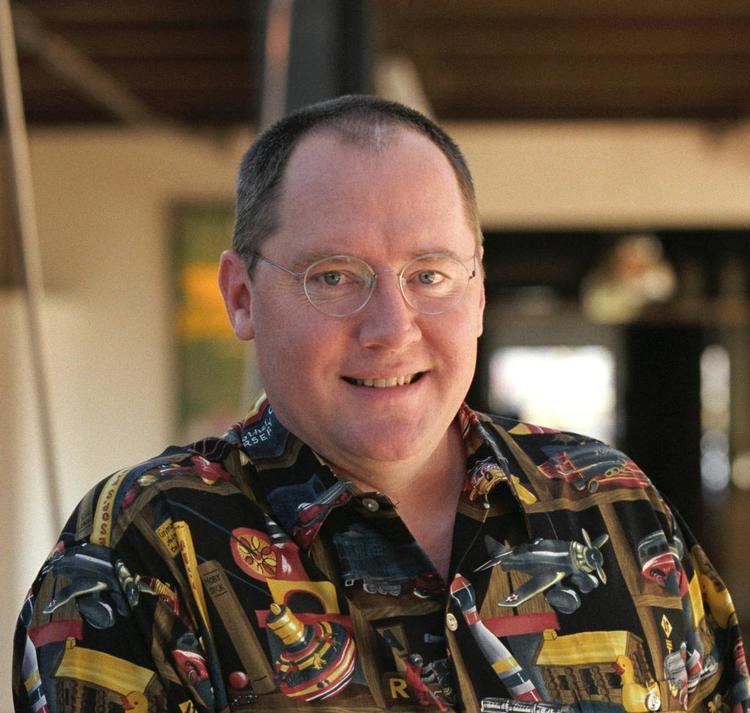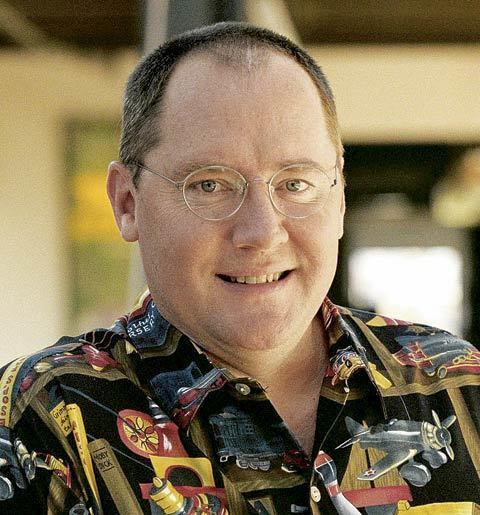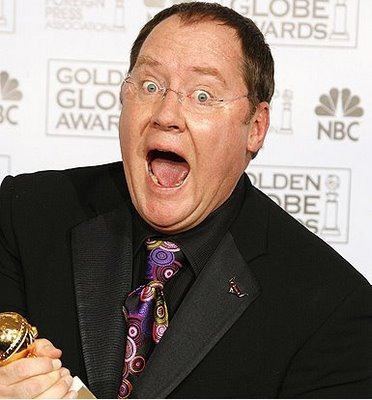Years active 1978–present Name John Lasseter | Spouse Nancy Lasseter (m. 1988) | |
 | ||
Full Name John Alan Lasseter Born January 12, 1957 (age 68) ( 1957-01-12 ) Hollywood, California, United States Alma mater Pepperdine UniversityCalifornia Institute of the Arts Occupation AnimatorFilm directorChief Creative Officer,Pixar Animation Studios,Walt Disney Animation Studios,DisneyToon StudiosPrincipal Creative Advisor,Walt Disney Imagineering Notable work Movies Toy Story, Cars, Cars 2, Toy Story 4, Toy Story 3 Children Sam Lasseter, Bennett Lasseter, Joey Lasseter, Paul James Lasseter, Jackson Lasseter Parents Paul Eual Lasseter, Jewell Mae Risley Books Toy Story: The Art and Making of, Toy Story The Art and Making of, A Bug's Life Similar People Andrew Stanton, Pete Docter, Lee Unkrich, Brad Lewis, Joe Ranft | ||
Ex-Disney Animators: Don Bluth, Tim Burton & John Lasseter | Disney Animation Discussion
John Lasseter - A Day in a Life - Full Length Documentary
John Alan Lasseter (born January 12, 1957) is an American animator, film director, screenwriter, and film producer. He currently is the chief creative officer of Pixar Animation Studios, Walt Disney Animation Studios, and DisneyToon Studios. He is also the Principal Creative Advisor for Walt Disney Imagineering.
Contents
- Ex Disney Animators Don Bluth Tim Burton John Lasseter Disney Animation Discussion
- John Lasseter A Day in a Life Full Length Documentary
- Early years
- First years at Disney
- LucasfilmPixar
- Return to Disney
- Other work
- Personal life
- References

Lasseter began his career as an animator with The Walt Disney Company. After being fired from Disney for promoting computer animation, he joined Lucasfilm, where he worked on the then-groundbreaking use of CGI animation. The Graphics Group of the Computer Division of Lucasfilm was sold to Steve Jobs and became Pixar in 1986. Lasseter oversees all of Pixar's films and associated projects as executive producer. In addition, he directed Toy Story (1995), A Bug's Life (1998), Toy Story 2 (1999), Cars (2006), and Cars 2 (2011). Since 2007, Lasseter also oversees all of Walt Disney Animation Studios' (and its division DisneyToon Studios') films and associated projects as executive producer.

He has won two Academy Awards, for Animated Short Film (for Tin Toy), as well as a Special Achievement Award (for Toy Story).

Early years

Lasseter was born in Hollywood, California. His mother, Jewell Mae (née Risley; 1918–2005), was an art teacher at Bell Gardens High School, and his father, Paul Eual Lasseter (1924–2011), was a parts manager at a Chevrolet dealership.

Lasseter is a fraternal twin; his sister Johanna Lasseter-Curtis, who became a baker based in the Lake Tahoe area, is six minutes older.
Lasseter grew up in Whittier, California. His mother's profession contributed to his growing preoccupation with animation. He often drew cartoons during church services at the Church of Christ his family attended. As a child, Lasseter would race home from school to watch Chuck Jones cartoons on television. While in high school, he read The Art of Animation by Bob Thomas. The book covered the history of Disney animation and explored the making of Disney's 1959 film Sleeping Beauty, which made Lasseter realize he wanted to do animation himself. When he saw Disney's 1963 film The Sword in the Stone, he finally made the decision that he should become an animator.
Lasseter's higher education began at Pepperdine University, which was the alma mater of his parents and his siblings. However, he heard of a new character animation program at the California Institute of the Arts (CalArts for short) and decided to leave Pepperdine to follow his dream of becoming an animator. His mother further encouraged him to take up a career in animation, and in 1975 he enrolled as the second student in the CalArts character animation program created by Disney animators Jack Hannah and T. Hee. Lasseter was taught by three members of Disney's Nine Old Men team of veteran animators – Eric Larson, Frank Thomas and Ollie Johnston, and his classmates included future animators and directors like Brad Bird, John Musker, Henry Selick, Tim Burton, and Chris Buck. During his time there, he produced two animated shorts — Lady and the Lamp (1979) and Nitemare (1980) — which both won the student Academy Award for Animation.
While at CalArts, Lasseter first started working for the Walt Disney Company at Disneyland in Anaheim during summer breaks and got a job as a Jungle Cruise skipper, where he learned the basics of comedy and comic timing to entertain captive audiences on the ride.
First years at Disney
Upon graduating in 1979, Lasseter immediately obtained a job as an animator at Walt Disney Feature Animation mostly due to his success with Lady and the Lamp. To put that in perspective, the studio had reviewed approximately 10,000 portfolios in the late 1970s in search of talent, then selected only about 150 candidates as apprentices, of which only about 45 were kept on permanently. In the fall of 1979, Disney animator Mel Shaw told the Los Angeles Times that "John's got an instinctive feel for character and movement and shows every indication of blossoming here at our studios ... In time, he'll make a fine contribution."
However, Lasseter soon realized something was missing: after 101 Dalmatians, which in his opinion was the film where Disney had reached its highest plateau, the studio had lost momentum and was criticized for often repeating itself without adding any new ideas or innovations. Between 1980 and 1981, he coincidentally came across some video tapes from one of the then new computer-graphics conferences, who showed some of the very beginnings of computer animation, primarily floating spheres and such, which he experienced as a revelation. But it wasn't until shortly after, when he was invited by his friends Jerry Rees and Bill Kroyer, while working on Mickey's Christmas Carol, to come and see the first lightcycle sequences for an upcoming film entitled Tron, featuring (then) state-of-the-art computer generated imagery (CGI), that he really saw the huge potential of this new technology in animation. Up to that time, the studio had used a multiplane camera to add depth to its animation. Lasseter realized that computers could be used to make films with three-dimensional backgrounds where traditionally animated characters could interact to add a new level of visually stunning depth that had not been possible before. He knew adding dimension to animation had been a longtime dream of animators, going back to Walt Disney himself.
Later, he and Glen Keane talked about how great it would be to make an animated feature where the background was computer animated, and then showed Keane the book The Brave Little Toaster by Thomas Disch, which he thought would be a good candidate for the film. Keane agreed, but first they decided to do a short test film to see how it worked out, and chose Where the Wild Things Are, a decision based on the fact that Disney had considered producing a feature based on the works of Maurice Sendak. Satisfied with the result, Lasseter, Keane and executive Thomas L. Wilhite went on with the project, especially Lasseter who dedicated himself to it, while Keane eventually went on to work with The Great Mouse Detective.
Lasseter and his colleagues unknowingly stepped on some of their direct superiors' toes by circumventing them in their enthusiasm to get the project into motion. During a pitch meeting for the film to two of them, animation administrator Ed Hansen, and head of Disney studios, Ron W. Miller, the project was cancelled, due to lack of perceived cost benefits for the mix of traditional and computer animation. A few minutes after the meeting, Lasseter was summoned by Hansen to his office. As Lasseter recalled, Hansen told him, "Well, John, your project is now complete, so your employment with the Disney Studios is now terminated." Wilhite, who was part of Disney’s live action group and therefore had no obligations to the animation studio, was able to arrange to keep Lasseter around temporarily until the Wild Things test project was complete in January 1984, but with the understanding there would be no further work for Lasseter at Disney Animation. The Brave Little Toaster would later become a 2D animated feature film directed by one of Lasseter's friends, Jerry Rees, and co-produced by Wilhite (who had, by then, left to start Hyperion Pictures), and some of the staff of Pixar would be involved in the film alongside Lasseter.
Lasseter also worked on a sequence titled "The Emperor and the Nightingale" (based on The Nightingale by Hans Christian Andersen) for a Disney project called Musicana. Musicana was never released, but eventually led to the development of Fantasia 2000.
Lucasfilm/Pixar
While putting together a crew for the planned feature, Lasseter had made some contacts in the computer industry, among them Alvy Ray Smith and Ed Catmull at Lucasfilm Computer Graphics Group. After being fired, and feeling glum knowing his employment with Disney was to end shortly, Lasseter visited a computer graphics conference in November 1983 at the Queen Mary in Long Beach, where he met and talked to Catmull again. Catmull inquired about The Brave Little Toaster, which Lasseter explained had been shelved. From his experience at Lucasfilm, Catmull assumed Lasseter was simply between projects, since Hollywood studios have traditionally laid off people whenever they don't have enough movies in progress to keep them busy. Still devastated at being forced out of the only company he had ever wanted to work for, Lasseter couldn't find the strength to tell Catmull that he had been fired.
Catmull later telephoned Smith that day and mentioned Lasseter was not working at Disney. Smith told Catmull to put down the phone and hire Lasseter right now. Before the day was over, Lasseter had made a deal to work freelance with Catmull and his colleagues on a project that resulted in their first computer animated short: The Adventures of André and Wally B. Because Catmull was not allowed to hire animators, he was given the title "Interface Designer"; "Nobody knew what that was but they didn't question it in budget meetings". Lasseter spent a lot of time at Lucasfilm in the San Francisco Bay Area in the spring of 1984, where he worked together closely with Catmull and his team of computer science researchers. Lasseter learned how to use some of their software, and in turn, he taught the computer scientists about filmmaking, animation, and art. The short turned out to be more revolutionary than Lasseter first had visualized before he came to Lucasfilm. His original idea had been to create only the backgrounds on computers, but in the final short everything was computer animated, including the characters.
After the short CGI film was presented at SIGGRAPH in the summer of 1984, Lasseter returned to Los Angeles with the hope of directing The Brave Little Toaster at Hyperion Pictures. He soon learned that funding had fallen through and called Catmull with the bad news. Catmull called back with a job offer, and Lasseter joined Lucasfilm as a full-time employee in October 1984 and moved to the Bay Area. Lasseter and Catmull's collaboration, which has since lasted over thirty years, would ultimately result in Toy Story (1995), which was the first-ever computer-animated feature film.
Due to George Lucas's financially crippling divorce, he was forced to sell off Lucasfilm Computer Graphics, by this time renamed the Pixar Graphics Group. It was spun off as a separate corporation with Steve Jobs as its majority shareholder in 1986. Over the next 10 years, Pixar evolved from a computer company that did animation work on the side into an animation studio. Lasseter oversees all of Pixar's films and associated projects as executive producer. As well as Toy Story, he also personally directed A Bug's Life (1998), Toy Story 2 (1999), Cars (2006), and Cars 2 (2011).
He has won two Academy Awards, for Animated Short Film (Tin Toy), as well as a Special Achievement Award (Toy Story). Lasseter has been nominated on four other occasions – in the category of Animated Feature, for both Monsters, Inc. (2001) and Cars, in the Original Screenplay category for Toy Story and in the Animated Short category for Luxo, Jr. (1986), while the short Knick Knack (1989) was selected by Terry Gilliam as one of the ten best animated films of all time. In 2008, he was honored with the Winsor McCay Award, the lifetime achievement award for animators.
Return to Disney
Disney announced that it would be purchasing Pixar on January 24, 2006, and Lasseter was named chief creative officer of both Pixar and Walt Disney Feature Animation, the latter of which he renamed Walt Disney Animation Studios. On January 25, 2006, Lasseter was welcomed by his new employees in Burbank with warm applause, as they hoped that he could save the studio from which he had been fired 22 years earlier. Lasseter was also named principal creative adviser at Walt Disney Imagineering, where he helps design attractions for Disney Parks. Since 2007, he oversees all of Walt Disney Animation Studios' films and associated projects as executive producer. He reports directly to Disney Chairman and CEO Robert Iger, bypassing Disney's studio and theme park executives. He also received green-light power on films with Roy E. Disney's consent.
In December 2006, Lasseter announced that Disney Animation will start producing animated shorts that will be released theatrically once more. Lasseter said he sees this medium as an excellent way to train and discover new talent in the company as well as a testing ground for new techniques and ideas. The shorts will be in 2D, CGI, or a combination of both. Recent shorts have included Feast (2014) and Inner Workings (2016).
In June 2007, Catmull and Lasseter were given control of DisneyToon Studios, a division of Walt Disney Animation Studios housed in a separate facility in Glendale. Since then, as president and chief creative officer, respectively, they have supervised three separate studios for Disney, each with its own production pipeline: Pixar, Disney Animation, and DisneyToon. While Disney Animation and DisneyToon are located in the Los Angeles area, Pixar is located over 350 miles (563 kilometers) northwest in the Bay Area, where Catmull and Lasseter both live. Since they could not be physically present at all three studios at once, they appointed a general manager for each studio to manage day-to-day business affairs, then established a routine of spending at least two days per week (usually Tuesdays and Wednesdays) in Southern California.
Lasseter is a close friend and admirer of Japanese animator Hayao Miyazaki, whom he first met when TMS Entertainment sent a delegation of animators to the Disney studio in 1981 and showed a clip from Miyazaki's first feature film, The Castle of Cagliostro (1979). Lasseter was so deeply moved that in 1985 he insisted on showing that clip and other examples of Miyazaki's work after dinner to a woman he had just met (who would become his wife). He visited Miyazaki during his first trip to Japan in 1987, and saw drawings for My Neighbor Totoro (1988). After Lasseter became a successful director and producer at Pixar, he went on to serve as executive producer on several of Miyazaki's films for their release in the United States, and oversaw the translation and dubbing of their English language soundtracks. The gentle forest spirit Totoro from My Neighbor Totoro makes an appearance as a plush toy in Toy Story 3.
Lasseter is a member of the Academy of Motion Picture Arts and Sciences and served nine consecutive years on its board of governors from 2005 to 2014 when he had to relinquish his seat due to term limits. His last position on the board was as first vice president.
Lasseter received a star on the Hollywood Walk of Fame in Hollywood on November 1, 2011, located at 6834 Hollywood Boulevard.
Other work
Lasseter drew the most widely known versions of the BSD Daemon, a cartoon mascot for the BSD Unix operating system.
Lasseter owns the "Marie E." steam locomotive, a H.K. Porter 0-4-0ST saddle tank locomotive formerly owned by one of Walt Disney's "Nine Old Men", Ollie Johnston. The locomotive has made two visits to the Pacific Coast Railroad in Santa Margarita, CA in May 2007 and June 2010, where Lasseter ran the locomotive alongside the original Santa Fe & Disneyland Railroad "Retlaw 1" coaches. In 2005, Lasseter was given permission to bring the Marie E. to Disneyland as part of a celebration honoring Johnston. Johnston was able to take the locomotive around the Disneyland Railroad three times. This is the only time in history an outside locomotive has been permitted to operate on any of the Disney railroads.
Personal life
Lasseter lives in Glen Ellen, California with his wife Nancy, a graduate of Carnegie Mellon University, whom he met at a computer graphics conference. Nancy majored in computer graphics applications, and worked for a while as a household engineer and a computer graphics engineer at Apple Computer. They married in 1988, and have five sons, born between 1979/1980 and 1997.
The Lasseters own Lasseter Family Winery in Glen Ellen, California. The property includes a narrow gauge railroad named the Justi Creek Railway (for the "Marie E.", the locomotive Lasseter purchased from Ollie Johnston) approximately 2 miles (3.2 km) long, including a train station and water tower Lasseter purchased from former Disney animator Ward Kimball. Their residence has a swimming pool with a lazy river that runs through a cave. Lasseter owns a collection of more than 1,000 Hawaiian shirts and wears one every day. Lasseter also inherited his late father's passion for cars; besides having directed two films about them, he watches auto races at Sonoma Raceway near his home and collects classic cars, of which one of his favorites is his black 1952 Jaguar XK120.
On May 2, 2009, Lasseter received an honorary doctorate from Pepperdine University, where he delivered the commencement address.
His influences include Walt Disney, Chuck Jones, Frank Capra, Hayao Miyazaki, and Preston Sturges. Lasseter's favorite film is Walt Disney's Dumbo.
